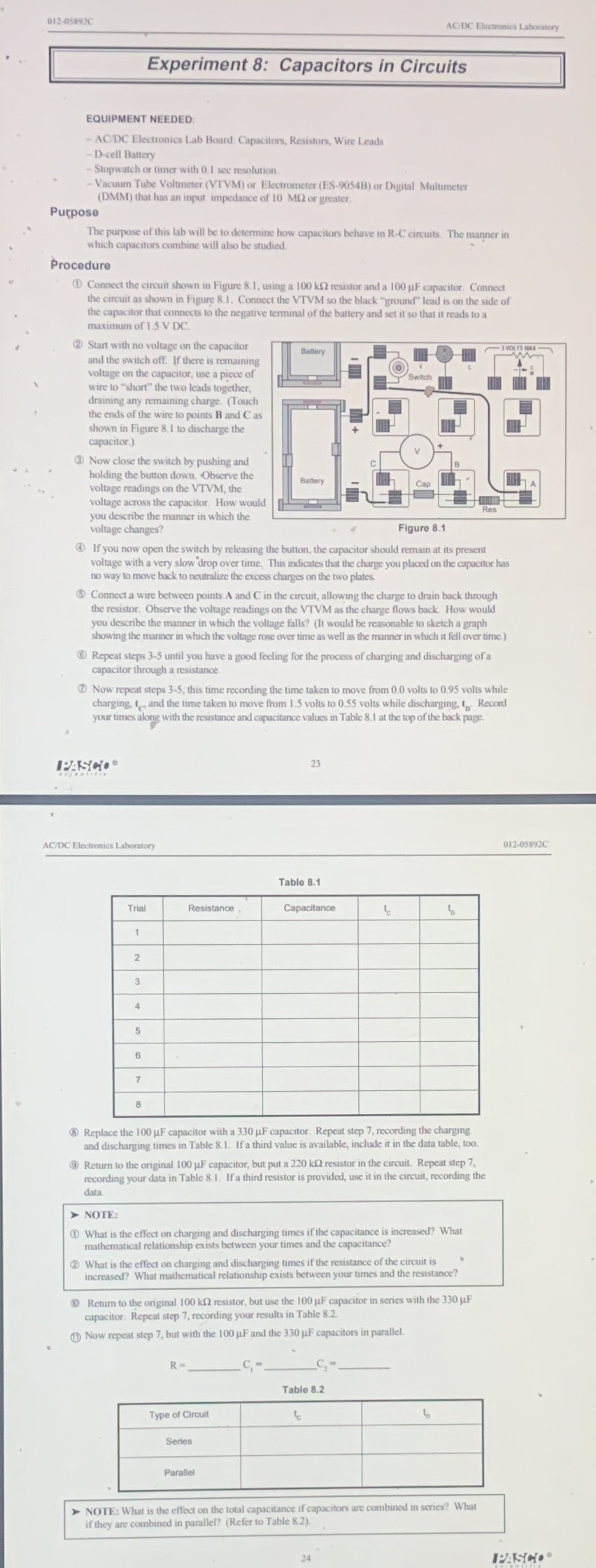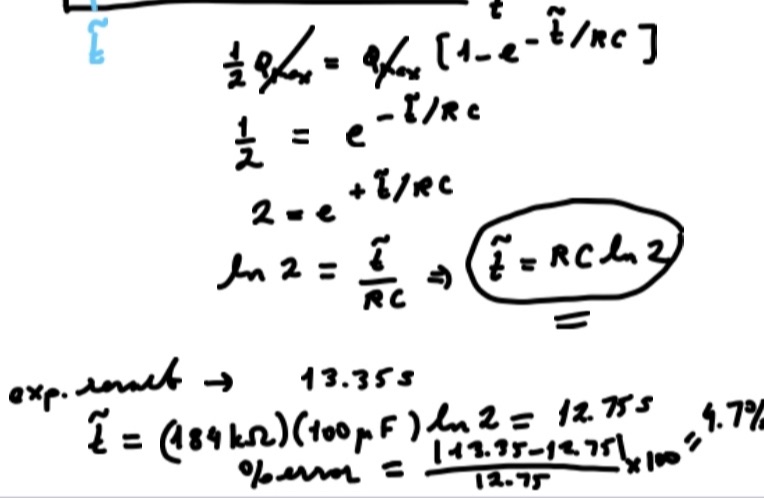Reference; AC/DC ELECTRONICS LABORATORY MANUAL
012-05892C AC/DC Electronics Laboratory Experiment 8: Capacitors in Circuits EQUIPMENT NEEDED: - AC/DC Electronics Lab Board: Capacitors, Resistors, Wire Leads - D-cell Battery - Stopwatch or timer with 0. I see resolution. - Vacuum Tube Voltmeter (VTVM) or Electrometer (ES-9054B) or Digital Multimeter (DMM) that has an input impedance of 10 M$2 or greater. Purpose The purpose of this lab will be to determine how capacitors behave in R-C circuits. The manner in which capacitors combine will also be studied. Procedure Connect the circuit shown in Figure 8.1, using a 100 k$2 resistor and a 100 JF capacitor. Connect the circuit as shown in Figure 8.1. Connect the VTVM so the black "ground" lead is on the side of the capacitor that connects to the negative terminal of the battery and set it so that it reads to a maximum of 1.5 V DC. 2 Start with no voltage on the capacitor -J VOLTS MAX and the switch off. If there is remaining M voltage on the capacitor, use a piece of O Switch wire to "short" the two leads together, draining any remaining charge. (Touch the ends of the wire to points B and C as shown in Figure 8. I to discharge the capacitor.) Now close the switch by pushing and holding the button down. Observe the Battery voltage readings on the VTVM, the Cap voltage across the capacitor. How would you describe the manner in which the voltage changes? Figure 8.1 If you now open the switch by releasing the button, the capacitor should remain at its present voltage with a very slow drop over time, This indicates that the charge you placed on the capacitor has no way to move back to neutralize the excess charges on the two plates. 5 Connect a wire between points A and C in the circuit, allowing the charge to drain back through the resistor. Observe the voltage readings on the VTVM as the charge flows back. How would you describe the manner in which the voltage falls? (It would be reasonable to sketch a graph showing the manner in which the voltage rose over time as well as the manner in which it fell over time.) Repeat steps 3-5 until you have a good feeling for the process of charging and discharging of a capacitor through a resistance Now repeat steps 3-5, this time recording the time taken to move from 0.0 volts to 0.95 volts while charging, t, and the time taken to move from 1.5 volts to 0.55 volts while discharging, to Record your times along with the resistance and capacitance values in Table 8. 1 at the top of the back page. PASCO. AC/DC Electronics Laboratory 012-05892C Table 8.1 Trial Resistance Capacitance to 2 3 5 6 Replace the 100 p.F capacitor with a 330 uF capacitor. Repeat step 7, recording the charging and discharging times in Table 8.1. If a third value is available, include it in the data table, too. Return to the original 100 uF capacitor, but put a 220 k$2 resistor in the circuit. Repeat step 7, recording your data in Table 8.1. If a third resistor is provided, use it in the circuit, recording the data. >NOTE: What is the effect on charging and discharging times if the capacitance is increased? What mathematical relationship exists between your times and the capacitance? 2 What is the effect on charging and discharging times if the resistance of the circuit is increased? What mathematical relationship exists between your times and the resistance? Return to the original 100 k$2 resistor, but use the 100 uF capacitor in series with the 330 uF capacitor. Repeat step 7, recording your results in Table 8.2. Now repeat step 7, but with the 100 J.F and the 330 JF capacitors in parallel. R = C, - Table 8.2 Type of Circuit Series Parallel NOTE: What is the effect on the total capacitance if capacitors are combined in series? What if they are combined in parallel? (Refer to Table 8.2). PAST..\f\f









